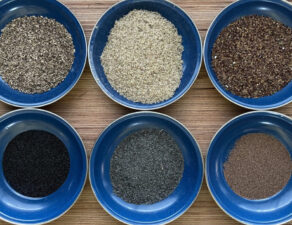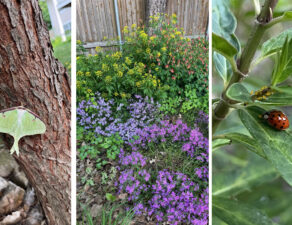
Photos by Tracy Twombly of Sow Wild Natives. Originally posted on the Sow Wild Natives Instagram and Facebook
As the sun sinks lower each day, night has been creeping in earlier and earlier, signaling the onset of winter. Our first hard killing frosts preceded the Thanksgiving holiday last month, bringing with it one of nature’s most intriguing ephemeral phenomena – frost flowers. For those of us who are fortunate enough to behold these one-of-a-kind formations of ice crystals, there’s an alluring mystique that entices us to select those native species whose beauty doesn’t wither when their green and blooms fade away into dormancy.
The scientific explanation for these phenomena highlights a sweet spot of conditions that only occur in late autumn, when the soil temperatures are still high enough for plants to be moving sap up through their stems, but air temperatures dip below freezing overnight. Square, or wing-stemmed species such as Dittany (Cunila origanoides) and Yellow Crownbeard (Verbesina helianthoides) will split vertically along the lower reaches of their stems the first time the plant freezes. Capillary action will push water slowly outward, where it freezes immediately upon contact with the air, forming eye-catching ribbons of delicate ice crystals that twist and curl into unique formations. No two frost flowers are alike, and even some of the most seasoned native plant enthusiasts have yet to cross them off their bucket list, as they’re so delicate that they quickly melt or even sublimate – vaporizing with the first warm kiss of sunlight.
One of those early-rising naturalists blessed to witness them this season was Tracy Twombly, owner of local nursery Sow Wild Natives in Kansas City, MO. Tracy noted that she first observed frost flowers on their inventory of Downy Skullcap (Scutellaria incana) a number of years ago but had missed the window for several autumns in a row. So, this season Tracy was adamant to hunt them down again, hawkishly watching the thermometer plunge and setting out at dawn each day after our first freezing temps. The diversity of species that bore frost flowers last month was a pleasant surprise to her. In addition to the showcase in their mass garden planting of Dittany, dozens more occurred in potted nursery stock that had been cut back for the winter. Other members of the mint family like Bee Balm (Monarda bradburiana), Blue Sage (Salvia azurea) and Slender and Hairy Mountain Mints (Pycnanthemum spp.) were all glistening in their wintery splendor. Even several species of Asters and Sunflowers had gotten in on the frosty fun!
Tracy suggested that in addition to her diligent observation, the sheer volume of native species available at Sow Wild Natives increases the odds of witnessing this cold season wonder. Though their retail season has ended for 2024, be sure to visit their Noland Road nursery next spring, where you’ll explore remarkable demonstration landscapes and find hundreds of species of regional native plants to buy. Their expert team will support you in choosing the best native plants from their vast inventory, guiding you in the proper care and site selection. With the right species, and by growing and expanding your own native landscapes, you might not have to hunt too long to cross this dazzling sight off your naturalist bucket list.







